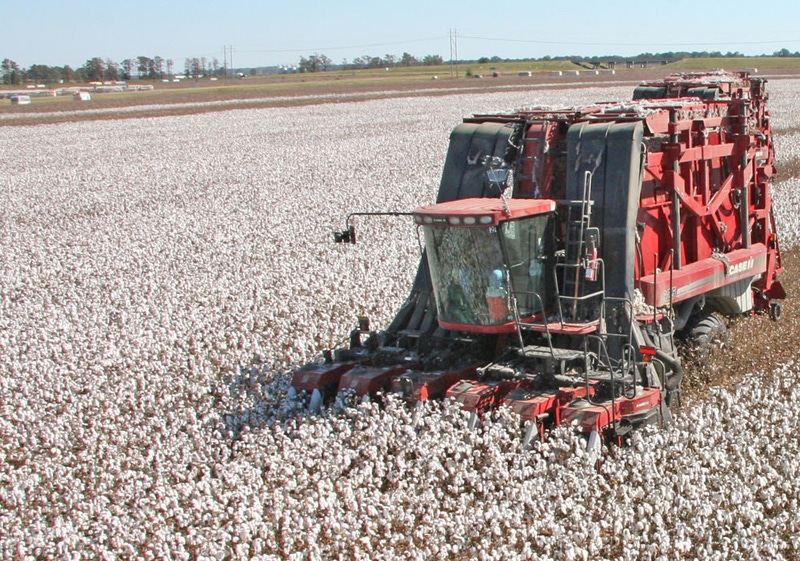
Below-dollar cotton prices and higher prices for corn, soybeans and peanuts appear to be taking a toll on 2012 cotton acreage.The National Cotton Council's Early Season Planting Intentions Survey normally provides the first survey-based snapshot of the size of the new year's cotton crops.NCC economists say the final outcome could vary depending on weather conditions and market changes by planting time.
February 11, 2012

The National Cotton Council says U.S. cotton producers could plant as many as 13.63 million acres of upland and extra long staple (ELS) cotton in 2012.
The 13.63-million-acre total, the amount growers responding to the NCC’s 29th Annual Early Season Planting Intentions Survey said they intend to devote to cotton, would be down 7.5 percent from 2011 planted acreage.
Farmers indicated upland cotton planting intentions of 13.34 million acres, down 7.5 percent from 2011, while ELS intentions of 287,000 acres represent a 6.4 percent decline. The survey results were announced today at the NCC’s 2012 annual meeting in Fort Worth.
With assumed above-average abandonment in Texas and Oklahoma and all other states set at historical averages, total upland and ELS harvested area would be 10.88 million acres, 20.3 percent below planted area. Applying state-level yield assumptions to projected harvested acres generates a cotton crop of 18.30 million bales, vs. 2011’s production of 15.67 million bales.
“Final production will be very dependent on weather developments, particularly in the southwestern U.S,” said Gary Adams, NCC vice president for economics and policy analysis. “If conditions worsen, we could see the U.S. crop be 2 million bales lower than early-season expectations.”
The NCC survey, mailed in mid-December 2011 to producers across the 17-state Cotton Belt, asked for their intended 2012 cotton acreage as well as for their intended plantings of other crops in 2012. Survey responses were collected through mid-January.
“The expected drop in cotton area is consistent with current market signals,” Adams noted. “Since 2011, cotton prices have weakened relative to competing crop such as corn, soybeans and peanuts.”
Southeast
Survey respondents throughout the Southeast indicated a decline in acreage in all states. In percentage terms, the largest declines are expected to be seen in Alabama and Virginia down 17.6 percent and 16.0 percent, respectively. In Alabama, cotton acres are shifting to corn, soybeans and peanuts. In Virginia, cotton acres are shifting into soybeans. Georgia’s expected acreage is off 12.7 percent as corn and peanuts are the beneficiaries of the reduced cotton acreage. Growers in North Carolina indicated an 11.3 percent decline as corn, soybeans and peanuts are increasing area. Both Florida and South Carolina are reporting intentions 10.0 percent below year-ago levels. In those states, cotton acres are reported to be moving into peanuts and soybeans.
Delta
In the Mid-South, survey results show that growers intend to plant 2.30 million acres, a decrease of 6.9 percent. With the exception of Missouri, all states indicate fewer acres of cotton relative to 2011. Cotton acres in Missouri are up slightly at 2.3 percent. Of the remaining states, Louisiana is showing the largest decline at 17.7 percent. Results indicate a move to both corn and soybeans. With a decline of 9.0 percent, Arkansas shows the next largest drop, with those acres moving to corn. Declines in Mississippi and Tennessee are 6.5 percent and 5.0 percent, respectively. In both states, growers are opting for more acres of corn at the expense of cotton.
Southwest
Southwest growers are indicating the smallest percentage decline with 5.3 percent fewer acres, lowering the regional total to 7.62 million acres. In aggregate, Kansas growers indicated essentially no net change in cotton area as the state total is expected to remain at 80,000 acres. Oklahoma acreage is showing a 10.0 percent decline as acres are moving to wheat. For Texas, respondents intend to reduce area by 5.1 percent. The relatively small drop in area could reflect the ongoing drought concerns and the need to maintain acres in a relatively drought-tolerant crop.
Far West
All states in the West region show decreases in upland plantings, with the region as a whole down 10.4 percent. In Arizona, intended area of 222,000 acres represents an 11.3 percent decrease from the previous year. The expected decrease in acreage is coming in response to reduced price expectations and increased competition from wheat. At the time of the survey, California farmers intend to plant 169,000 acres (-7.4 percent), with the decrease due to a shift into specialty crops. California’s actual plantings could ultimately be dictated by water costs and availability. New Mexico is reporting intentions of 58,000 acres, down 15.0 percent.
Pima
With ELS prices down from year-ago levels and concerns about water availability in California, survey results indicate that U.S. cotton growers intend to decrease ELS plantings 6.4 percent to 287,000 acres in 2012. The results across the four ELS-producing states are mixed as New Mexico indicated an increase of 9.8 percent, bringing the states acreage up to 3,700 acres. The remaining states are expecting to reduce area relative to the previous year.
You May Also Like



